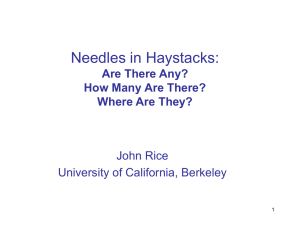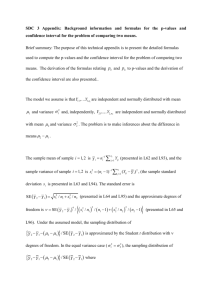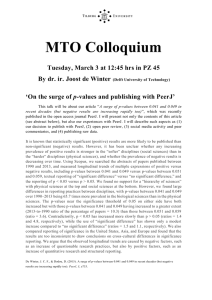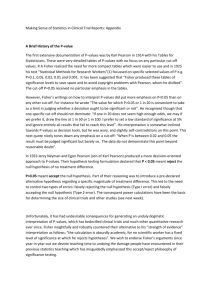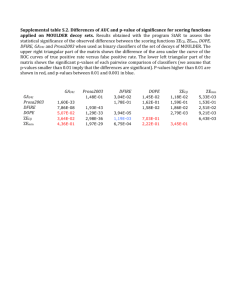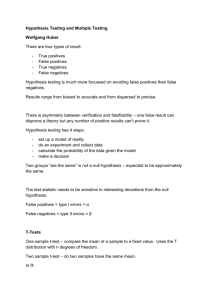BH_proof
advertisement
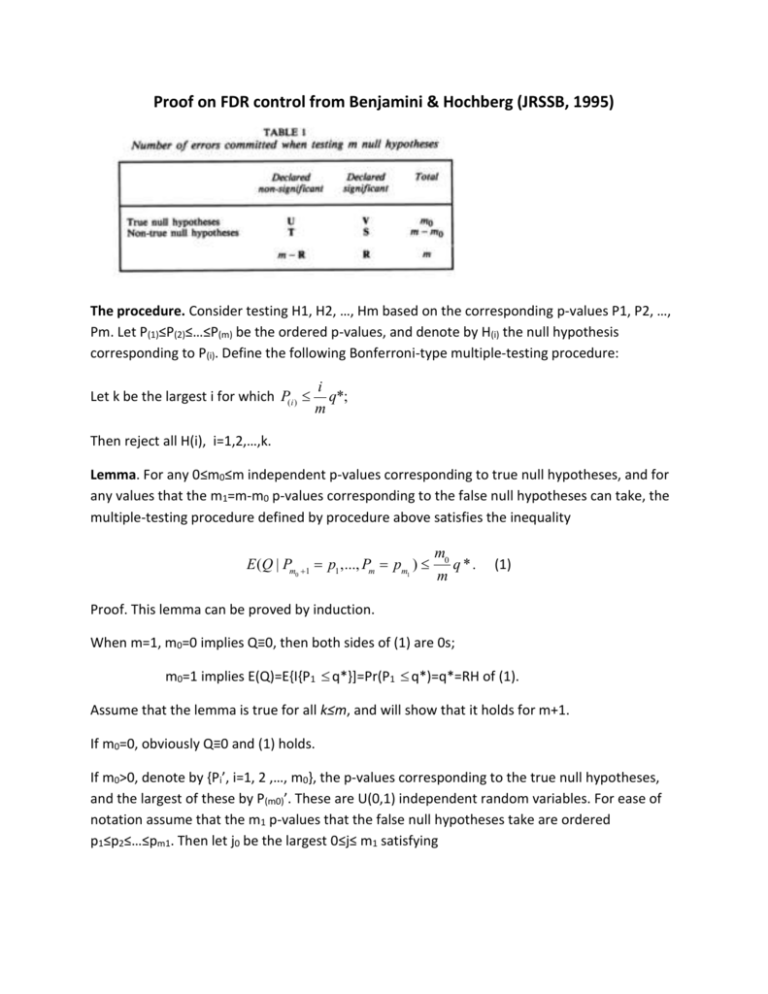
Proof on FDR control from Benjamini & Hochberg (JRSSB, 1995)
The procedure. Consider testing H1, H2, …, Hm based on the corresponding p-values P1, P2, …,
Pm. Let P(1)≤P(2)≤…≤P(m) be the ordered p-values, and denote by H(i) the null hypothesis
corresponding to P(i). Define the following Bonferroni-type multiple-testing procedure:
Let k be the largest i for which P(i )
i
q*;
m
Then reject all H(i), i=1,2,…,k.
Lemma. For any 0≤m0≤m independent p-values corresponding to true null hypotheses, and for
any values that the m1=m-m0 p-values corresponding to the false null hypotheses can take, the
multiple-testing procedure defined by procedure above satisfies the inequality
E(Q | Pm
0 1
p1 ,..., Pm pm )
1
m0
q *.
m
(1)
Proof. This lemma can be proved by induction.
When m=1, m0=0 implies Q≡0, then both sides of (1) are 0s;
m0=1 implies E(Q)=E{I{P1 q*}]=Pr(P1 q*)=q*=RH of (1).
Assume that the lemma is true for all k≤m, and will show that it holds for m+1.
If m0=0, obviously Q≡0 and (1) holds.
If m0>0, denote by {Pi’, i=1, 2 ,…, m0}, the p-values corresponding to the true null hypotheses,
and the largest of these by P(m0)’. These are U(0,1) independent random variables. For ease of
notation assume that the m1 p-values that the false null hypotheses take are ordered
p1≤p2≤…≤pm1. Then let j0 be the largest 0≤j≤ m1 satisfying
pj
m0 j
q*,
m1
(2)
and denote the right hand side of (2) at j0 by p ''
m0 j0
q*, .
m1
Conditioning on P(m0)’=p,
E (Q | Pm0 1 p1 ,..., Pm pm1 )
p"
E (Q | P
'
( m0 )
p, Pm0 1 p1 ,..., Pm pm1 ) f P' ( p)dp
(3)
( m0 )
0
1
E (Q | P('m0 ) p, Pm0 1 p1 ,..., Pm pm1 ) f P' ( p)dp.
( m0 )
p"
Because P(m0)’ is the largest one of m0 independent U(0,1) variables, we have
f P' ( p) m0 p m0 1.
( m0 )
In the first part of (3), p≤p”. Then among the p-values for the m0 nulls and the j0 smallest pm j
values among the false nulls, their maximum is smaller than p " 0 0 q * , but
m 1
m j 1
p j0 1 0 0 q * .
m 1
Therefore only the first (m0+ j0) hypotheses would be rejected and V= m0 and Q
Then
p"
E(Q | P
'
( m0 )
p, Pm
0
1
p1 ,..., Pm pm ) f P' ( p) dp
1
0
p"
m0
m0
m 1
m0 p 0 dp
p ''
j0
m0 j0
0
m
0
( m0 )
m0
p ''
m0 j0
m0 1
m0
m0 j
m
q* 0 q * p ''
m1
m1
m0 1
For the second component of (3), consider two scenarios:
m0
.
m0 j0
(a) p j0 p j p(' m0 ) p p j 1, for some j j0
(b) p j0 p " p(' m0 ) p p j0 1
m0 j
q * , therefore the true null corresponding to P(m0)’ and the
m 1
false nulls corresponding to p(j+1),…,pm1 all would be accepted. The rejection or acceptance of
the other hypotheses would not depend on the actual values of P (m0)’=p, p(j+1), …, pm1. The same
is true for (b) as well, except that j is replaced by j0.
Under (a), p(' m0 ) p p j
Therefore for the remain (m0+j-1) hypotheses, the procedure is to find out the largest k≤ m0+j-1,
such that P(k)≤{k/(m+1)}q*, where P(k) is the kth smallest p-value from the set
{Pi’, i=1, 2 ,…, m0-1} U { p1,p2, …, pj}
Or equivalently
p( k )
p
m0 j 1
k
q *.
m0 j 1 (m 1) p
Because condition on P(m0)’=p, {Pi’/p, i=1, 2 ,…, m0-1} are (m0-1) independently distributed U(0,1)
variables,0≤ pi/p≤1 are numbers corresponding to false null hypotheses. Then the false
discovery rate Q is the same as the one from controlling the false discovery rate among (m 0-1)
true nulls and j false nulls with p-values { Pi’/p, i=1, 2 ,…, m0-1; pi/p, i=1,2,…,j} with false
m j 1
discovery bound by 0
q *.
(m 1) p
Applying the induction, we have
1
E(Q | P
'
( m0 )
p, Pm
0
1
p1 ,..., Pm pm ) f P' ( p) dp
1
p"
1
m0 j 1
k
q * f P' ( p) dp
( m0 )
j
1
(m
1)
p
0
m
p"
1
k
(m 1) p q * m p
m0 1
0
dp
p"
m0
m1
( m0 1)
q *{1 p"
}.
Summing the two parts, we got
( m0 )
E(Q | Pm
0 1
p1 ,..., Pm pm )
End of proof.
1
m0
q *{1 p"
m1
( m0 1)
}
m0
q * p ''
m1
m0 1
m0
q *.
m


